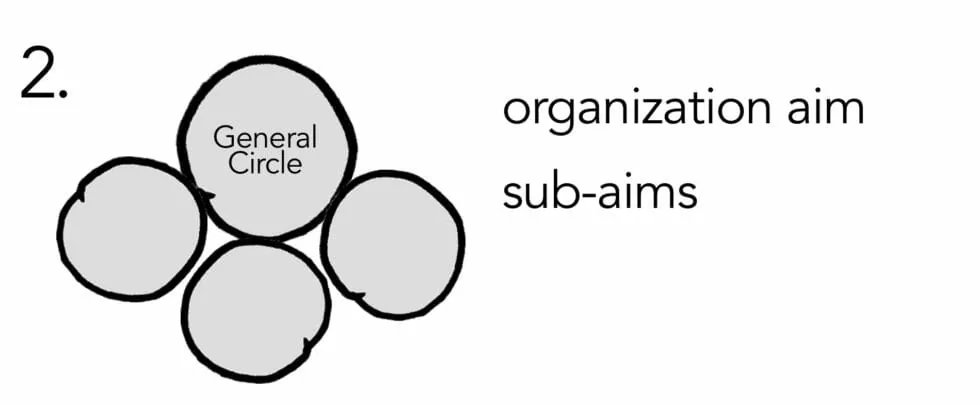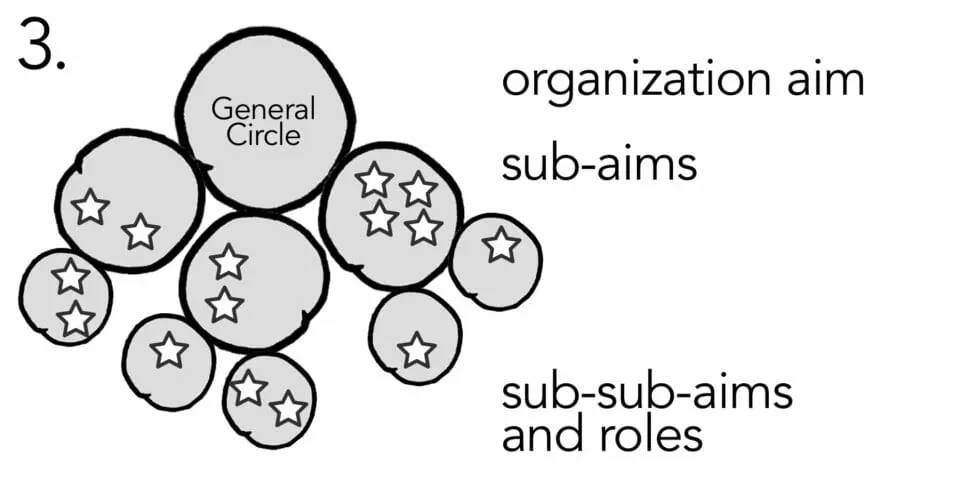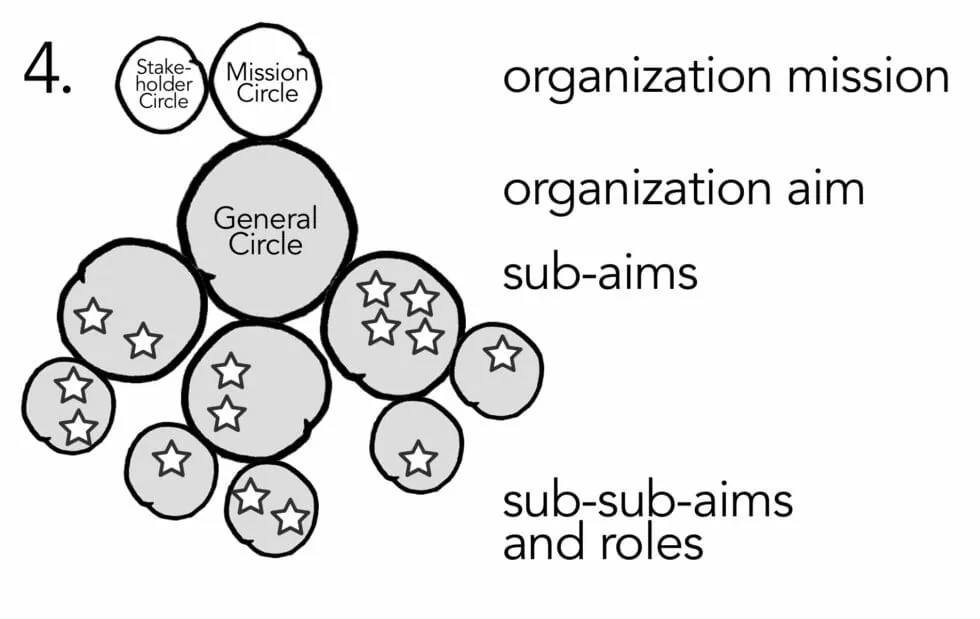Language: Español

- Your overall aim(s)
- Your sub-aims
- Sub-sub aims and roles
- Plug it together
- Transition power and try out the new structure
- Summary
This is a step-by-step guide to designing a circle structure in your organization. Every organization will be different. I will touch on common misconceptions I see but in my experience, people often remain – very understandably – caught up in their current structure and can’t detach from it enough to embrace a new way of thinking. So you might still need help. Sociocracy For All has people who enjoy thinking through circle structures with others – and sometimes just having an outside view is a huge help.
For this article, I will focus on existing non-sociocratic organizations that want to adopt sociocracy and shift their governance structure to a sociocratic structure with linked, nested circles. (To make things work, you’ll also have to decentralize power, responsibility, and authority into those circles!) If you are looking instead for resources on how to start a new group or organization with sociocracy, look at SoFA’s basic resources page, attend an event, or consider getting the ‘Who Decides Who Decides?’ book.
1. Know your overall aim(s)

Everything starts with the aim of the organization. What is your aim? It’s something more specific than your mission. Many of us want to make this world a better, more just, and more beautiful place, but what is your organization specifically doing to achieve that? Are you producing and selling things? Or are you hosting conferences? Or are you providing online resources, offering training, fundraising for racial justice, coding widgets, designing social media campaigns, and maintaining a community space? Write it down. It can be more than one aim but it should not be more than 3 sentences.
The ultimate measure of whether you succeeded in writing aims is when you tell an uninvolved person the aim, and they have a clear picture of what you’re doing.
For example, “holding space for social change agents” is not clear. Do you mean hosting in-person gatherings once a year? Or do you mean a network on social media? Do you mean giving out resources and making nice visuals to promote tools that help people hold space for each other? These are very different organizations. Be specific. Imagine your elderly aunt cutting through the wishy-washy and asking, “ok, so what do you actually do”? That’s what your aim is. It’s the classic: if you can’t say it in a simple sentence, you probably haven’t thought it through enough.
Aims that work:
- “running nonviolence training for activists”
- “running a grocery store in Manchester”
- “offering a complete social media service for social change organizations”
2. Know your sub-aims

From the overall aim, go to the more specific aims. To find those sub-aims, I often ask clients, “ok, so to achieve to overall aim, what needs to happen?” Ideally, you give 2-5 statements. Try not to think too small. Yes, someone needs to answer emails and someone needs to buy the paper for the printer – but that’s not the first thing that comes to mind, right? (Unless you’re a copy shop or printing is core to your work, of course.)
Where can we get lost?
What I notice during this step is that people sometimes get lost in three different areas:
- Don’t think in traditional departments, instead, think in action.
- Don’t try to cluster aims around people who happen to be doing a set of things in your current system.
- Example: Just because Fred is typically the one picking up guest speakers from the train station and is the treasurer that doesn’t mean those two tasks will live in the same circle.
- Don’t think in demographics (e.g. “volunteers”, “parents”).
Example: just because you have volunteers and staff doesn’t mean you have a “volunteer circle” and a “staff circle”. In this example, it’s easy to see that the aims are a more useful starting point. What does a volunteer circle do? Or better, what do volunteers do and how can people who do things (volunteers or not) be clustered into action teams with meaningful labels?
Stakeholder groups (like parents/students/teachers/alumni of a school, owners, and workers in a cooperative) can be represented on mission circle level (see stakeholder circles in our book Many Voices One Song) but an alumni circle – probably – has nothing to do with the organization operationally. (Of course I can think of examples where they might, for example when alumni hold a mentoring role that entails operational involvement, like in a mentor-child life skill afterschool program where alumni become mentors, but I am talking about broad sweeps here. Plus even in this example, they’d act as mentors operationally, not as alumni because operationally, what they do now is relevant.)
When you can assign them circles
Once you have a list of 2-5 meaningful aims, you can assign them circles. If you have more than 5, you might want to cluster them and make a few of them sub-circles under another circle.
Your list of aims now looks a little like ours in Sociocracy For All early on (for the current SoFA structure click here):
- Content Circle: “Spreading sociocracy with accessible, educational and inspirational materials about sociocracy.”
- Training Circle: “Spreading sociocracy through training and consulting.”
- Community Network Circle: “Networking and supporting the sociocracy world, including SoFA members, sociocratic practitioners and promoters, and regional and language-oriented groups.”
- Support Circle: “Providing SoFA infrastructure and administrative systems so that there is ease in running the organization.”
In order to make sociocracy accessible to everyone (our overall aim), someone needs to write and post stuff, someone needs to train people, someone needs to connect people who are trained to make sure it remains accessible, and someone needs to take care of the internal health of the organization. That’s it. Or for another fictional organization, someone needs to produce stuff, someone needs to sell stuff, someone needs to take care of the shared systems of the organization.
3. Sub-sub aims and roles

Now think about the sub-sub aims. For example, those who sell stuff, what needs to happen so they can sell stuff? They might have to provide a platform to sell, they need to ship things and they need to market the product. Depending on how much need there is operationally, things might shift a little – sometimes we form a sub-circle a little closer to one aspect, sometimes a little closer to something else. Or maybe you decide that outreach is a big part of the work and that it deserves to be a top-level department circle.
Some aspects might be taken care off by an operational role that lives in a circle. You don’t need an extra circle for everything. For example, sometimes I see clients build counterparts of “restocking the printers with paper” circles for each department just because all departments use computers and printers. Instead, have one role like that in SoFA’s support circle (above) or any other appropriate circle.
Keep in mind:
- Make sure every circle has a doable and meaningful contribution to make.
- Don’t overbuild. Put as much as possible into roles. Don’t form circles around things that don’t require cooperation or shared deliberation.
- Your structure won’t be perfect. Make it good enough and pay attention to what needs tweaking.
- A good structure is a structure where each can just do what they are there for with minimal friction so that minds are freed up to think about their overlap with others but don’t have to coordinate all the time.
- Sometimes one circle relies on the information from another circle – that doesn’t mean they have to be in charge of getting that information together. One circle can be in charge, and the way information flows is coordinated.

4. Then, plug it together
The rest is standard: your main aims give you your department circles’ aims. For alignment and coordination, form a general circle between department circles. Sub-aims determine sub-circles.
Connect everything with people in linking roles (leaders and delegates).
The Mission Circle oversees how the mission is expressed in the overall aim(s). Stakeholder circles might be formed to give input on Mission Circle level.
5. Finally, transition power and try out the new circle structure in your organization
It’s not trivial to transition over an existing structure into a circle structure. You’ll need to figure out who selects the original sets of leaders and circle members. You need to decide who is a decision-maker on the circle structure that you decide to start out with.

There are two basic approaches: jumping off the cliff and transitioning every circle at the same time.
The advantage is that there is a clear beginning and a clear transition of power. The other approach is to establish circles in an incremental fashion. That might reduce the moving parts you’ll have in the air at the same time – yet it also means a longer transition period where things might not fit together perfectly yet, like keeping the wiring working when re-building a house room by room. Reach out for help! Others have done it before.
Stay alert to see how things are working.
I don’t think I have ever seen an organization implement sociocracy without adjusting the circle structure very early on. You might have stretched yourselves too thin and formed too many circles. Or you might not have noticed how much two given circles need to align themselves. Or you might not have formed an intermediary circle where one is clearly needed.
Your circle structure is never complete or “done”.
(Look at MVOS section 2.2.1 to read about reviewing aims with the goal of improving alignment and clarity.) Things will always shift over time – maybe in the long run not at the department circle level, but certainly on the sub-circle level. You might move a circle closer to the General Circle because priorities in the organization change. Your funding streams might change and departments might close and new projects start. Like a person’s health requires ongoing attention, your organization’s health requires ongoing attention, and that includes the circle structure.
Summary
If you want to transition an organization to become sociocratic, there are a number of steps you can follow so to transform the organizational structure into linked, nested circles.
- Get clarity around your organization’s aim (remember: aim ≠ mission).
- Move to some sub-aims: write down few sentences and then assign them to (department) circles.
- Think about sub-sub-aims and how they could be held by sub-sub-circles and operational roles.
- Then, connect everything with linking roles (delegates and leaders) and a General Circle.
- Finally, decide what approach to adopt in order to transition from the existing structure into the new one.
Remember, an organization’s structure is never done or complete, but always evolving! So keep adjusting from early on.




Leave a Reply
You must be logged in to post a comment.